How to Optimize an Amazon Listing to Drive More Sales: X Tactics

Is your Amazon listing a ghost town? Crickets chirping, tumbleweeds rolling… not exactly the image of a thriving business, is it?
The brutal truth is that most Amazon listings are nothing more than digital shelf warmers. They exist, sure, but they don’t attract attention, they don’t generate excitement, and they certainly don’t drive sales.
But it doesn’t have to be that way. Your listing has the potential to be a bustling marketplace, a magnet for eager buyers, a cash-generating machine. But to get there, you need to stop treating it like an afterthought and start treating it like the valuable asset it is.
In this blog, we’re going to teach you how to turn your listing into a showstopper. We’ll reveal the secrets to crafting a listing that ranks high in search results and compels shoppers to click, browse, and buy.
Consider this your ultimate guide to Amazon search optimization; no fluff, just actionable tactics that will transform your listings and your bottom line. Let’s show you the way.
What Are Amazon Product Listings?
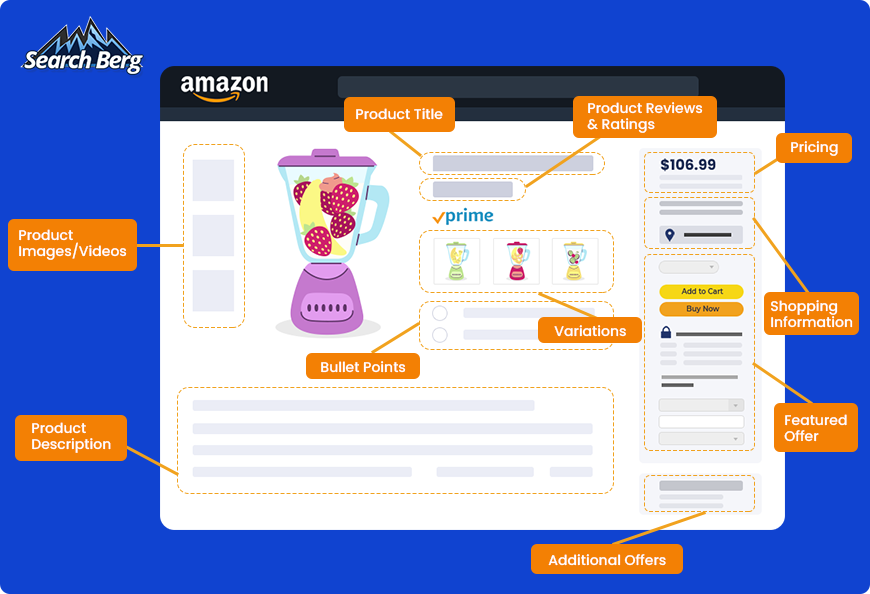
Wondering how to list products on Amazon? It all starts with Amazon listing creation.
An Amazon product listing is a product page that lives within the vast Amazon ecosystem. A well-optimized product listing is like a well-oiled machine, with each component working in harmony to drive conversions.
Here’s a breakdown of the key elements:
- Product Title: This is your product’s headline, its first impression. It needs to be informative, keyword-rich, and attention-grabbing.
- Product Images/Videos: High-quality, professional images and videos are non-negotiable. They showcase your product in its best light, giving shoppers a clear idea of what they’re buying.
- Variations: If your product comes in different sizes, colors, or styles, make sure you display these variations to cater to diverse customer preferences.
- Bullet Points: These concise snippets of information highlight your product’s key features and benefits. Think of them as your product’s elevator pitch.
- Product Description: This is your opportunity to tell your product’s story, delve into the details, and answer any questions a shopper may have.
- Pricing: Competitive pricing is essential on Amazon. Actively research your competitors and ensure your prices are in line with (or ideally, lower than) theirs.
- Shipping Information: Clearly display shipping costs and estimated delivery times to set clear expectations for your customers.
- Featured Offer: This section, previously known as the “Buy Box,” allows customers to easily add items to their shopping carts with a single click. It’s awarded to sellers based on various factors, including price competitiveness, seller performance metrics, and inventory availability.
- Additional Offers: If you offer additional products or services, e.g., warranties or bundle deals, showcase them here to entice shoppers and increase your average order value.
What Exactly is Amazon Search Optimization?
You’ve taken the plunge and created your Amazon seller profile. You’ve meticulously crafted your product listings, filled them with vibrant images and persuasive descriptions. But then reality hits. Your listings are barely making a dent in the vast Amazon marketplace. It’s like trying to find a needle in a haystack, except the haystack is constantly growing.
Creating a listing is just the first step. The real challenge lies in making sure your listing gets seen by the right shoppers. This is where Amazon Search Optimization (ASO) comes into play.
ASO is the strategic process of improving a product listing’s visibility and ranking within Amazon’s search results. It involves a blend of understanding Amazon’s algorithm, incorporating relevant keywords, and creating a compelling product page that resonates with both shoppers and the search engine.
At its core, ASO aims to ensure your product appears when potential customers search for items like yours. Mastering ASO, however, requires a deep dive into Amazon’s ever-changing algorithm, a keen eye for detail, and a willingness to experiment and adapt. That’s why partnering with professionals who specialize in Amazon SEO can be a game-changer. These experts can take the guesswork out of ASO, leveraging their knowledge and experience to optimize your listings for maximum visibility and sales.
Which proven tactics will your Amazon SEO team employ to elevate your product rankings and visibility? Let’s find out.
Amazon Listing Optimization Strategies
1. Learn & Master the Keyword Ropes
Ever feel like your Amazon listings are speaking a different language than your customers? Like you’re shouting “Buy me!” while they’re searching for something else entirely? That disconnect is often due to a lackluster keyword strategy.
Keywords are the lifeblood of Amazon. They’re the invisible thread that connects your product with the shoppers who are actively seeking it. If you’re not using the right keywords, you’re essentially invisible, lost in a sea of irrelevant search results.
Want to master keywords? Stop sprinkling them haphazardly throughout your listing. Instead, understand the language of your target audience, anticipate their search queries, and strategically place those keywords in the right places to maximize your visibility.
Think of it as a game of cat and mouse. Amazon’s algorithm is the cat, constantly refining its search capabilities. Your job is to be the clever mouse, staying one step ahead by using the right keywords to lure the cat (and potential customers) to your doorstep with Amazon listings.
Cracking the Keyword Code
The first step in mastering keyword ropes is understanding the different types of keywords:
- Short-Tail Keywords: These are broad, generic terms like “laptop” or “shoes.” They have high search volume but also high competition, making it difficult to rank for them unless you’re a major brand.
- Long-Tail Keywords: These are more specific phrases like “waterproof hiking boots” or “15-inch gaming laptop with RTX graphics.” They have lower search volume but also lower competition, making them easier to rank for and more likely to attract qualified buyers.
- LSI Keywords: Latent Semantic Indexing (LSI) keywords are terms related to your main keyword. They help Amazon understand the context of your listing and match it with relevant searches. For example, LSI keywords for “coffee maker” may include “drip coffee,” “espresso machine,” or “French press.”
But how do you find the right keywords for your product? That’s where keyword research comes in. You can use a variety of tools and techniques, from Amazon’s own search bar to Search Berg’s specialized keyword research software. The key is to identify a mix of high-volume, low-competition keywords that accurately reflect your product and its benefits.
Where to Place Your Keywords
Once you’ve compiled your keyword arsenal for Amazon listing, it’s time to strategically deploy them throughout your listing.
- Product Title: Your title is the most important place to include your main keyword, as it’s the first thing shoppers see and a major factor in search rankings. Think of it as the headline of your product’s newspaper article; it needs to grab attention and accurately reflect the content that follows. But don’t just cram keywords in for the sake of it. Make sure your title is readable, informative, and enticing to potential buyers.
- Product Description: Your description is your chance to tell your product’s story in more detail. This is where you can weave in LSI keywords and provide additional context about your product’s features, uses, and benefits. Think of it as the body of your product’s newspaper article: informative, engaging, and packed with relevant details.
- Back end Search Terms: Amazon allows you to enter hidden keywords in the backend of your listing. This is your secret weapon for boosting visibility. Think of it as the metadata of your product’s article: hidden from view, but still essential for search engines to understand and index your content. Use this space to include synonyms, variations, and other relevant terms that may not fit naturally in your visible content.
Remember, relevance is key. Avoid the temptation to overload your listing with irrelevant terms, as this can actually harm your visibility. Instead, focus on using a diverse mix of short-tail and long-tail keywords that accurately reflect your product and its benefits. Most importantly, ensure your keywords flow naturally within your content, enhancing the overall readability and appeal of your listing. The goal is to attract genuine buyers, not trick the algorithm.
Examples
These listings have secured their position in the top search results. What makes them stand out? Let’s find out.

- OwalaFreeSip: This listing uses a combination of short-tail (“stainless steel water bottle”) and long-tail keywords (“BPA-free sports water bottle”) to capture a wide range of searches. They also mention the size (“32 oz”) and a key benefit (“straw”), making it clear to potential buyers what the product is and why they might need it.
- Hydro Flask: This listing focuses on the brand name (“Hydro Flask”) which itself is a powerful keyword due to brand recognition. They also include important product attributes like “stainless steel,” “standard mouth,” and “double-wall vacuum insulation,” further clarifying the product’s features and benefits.
- CIVAGO: Similar to Owala, this listing uses a mix of short-tail and long-tail keywords, including “insulated water bottle,” “stainless steel,” and “sports water cup flask.” They also cleverly incorporate “3 lids” and “wide mouth,” emphasizing versatility and functionality.
- CamelBak: This listing includes important product attributes like “vacuum insulated” and “stainless steel.” They also mention a specific feature, the “chute mag,” which is a popular search term for their target audience.
While all four listings use keywords effectively, they also demonstrate a key principle of Amazon SEO: keyword stuffing isn’t the goal. Instead, the keywords flow naturally within the title, making it informative and appealing to both shoppers and Amazon’s algorithm.
2.Let Your Images Do the Talking
Let’s look at the top Amazon search results for a hoverboard.
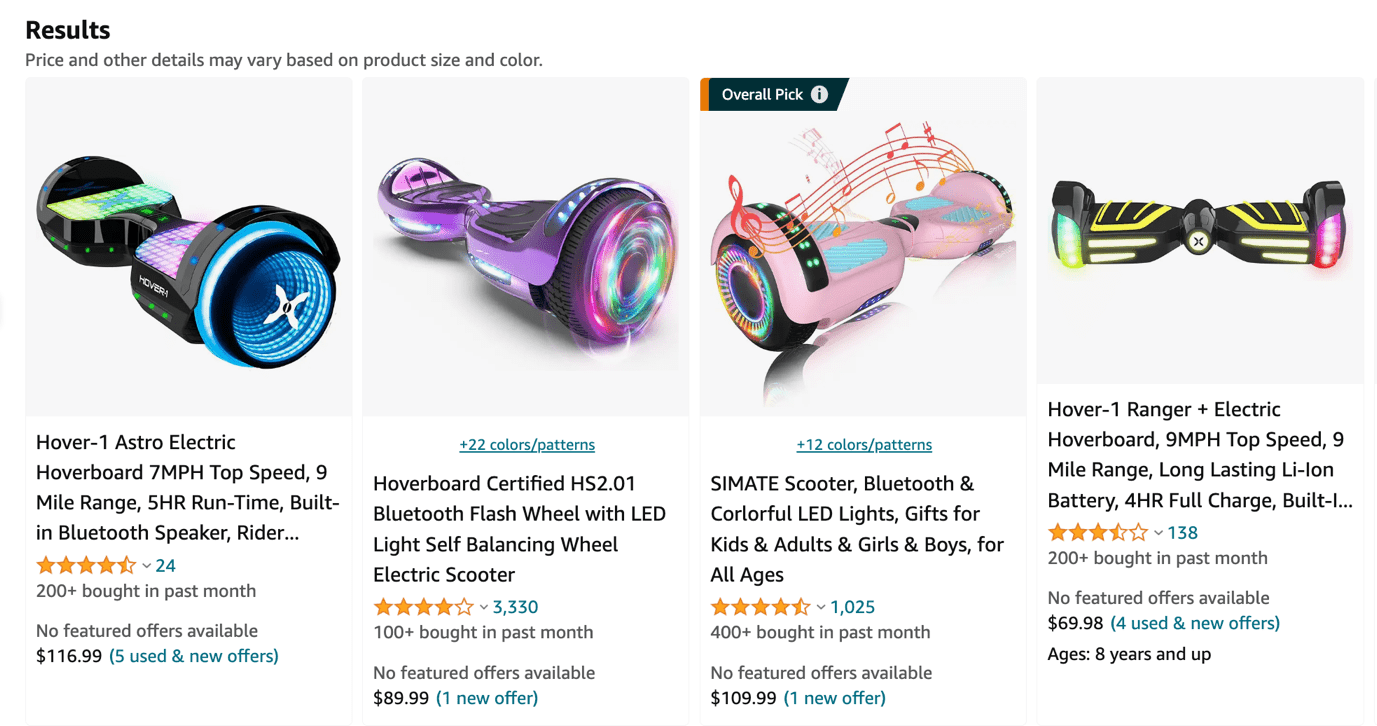
Notice something interesting? Every single listing features high-quality, visually stunning photos that immediately grab your attention.
These images aren’t just pretty pictures; they’re strategic marketing tools. Each photo cleverly targets the young audience interested in hoverboards. The bright colors and dynamic lighting effects leap off the screen, creating a sense of excitement and energy among kids. The sleek designs and chrome finishes hint at a premium, high-tech product that would appeal to tech-savvy teens.
These top-performing brand son Amazon listing sunderst and that visuals are more than just decoration; they’re a powerful tool for communicating a product’s essence and appeal. By crafting images that resonate with their target audience, these brands are driving engagement and sales.
In a world of instant gratification and short attention spans, your product images need to captivate, inform, and entice in a matter of seconds. A poorly lit, blurry, or uninspiring image can be the kiss of death, sending shoppers scurrying to your competitors’ offerings. But a well-crafted, optimized image? That’s a powerful tool that can stop them in their tracks, pique their curiosity, and drive them to click that “Add to Cart” button.
The Recipe for Quality Amazon Listing Photos
Before adding images to your listing, make sure they meet these criteria:
- Amazon’s Image Requirements: You want your listing to rank high, not descend to the bottom ranks. Strictly follow Amazon’s image requirements. Use JPEG (.jpg or .jpeg) as it’s the most widely accepted format on Amazon. Your photos should be in sRGB color mode for accurate color representation across different devices. The main image must have a pure white background (RGB 255, 255, 255).
- High Resolution: Your images should be crisp, clear, and free of pixelation. Aim for a resolution of at least 1000 pixels on the longest side. This ensures your images look sharp even when zoomed in, allowing shoppers to examine your product in detail.
- Proper Lighting: Good lighting is essential for showcasing your product’s true colors and textures. Use natural light whenever possible, or invest in professional lighting equipment for a consistent look across all your images. Avoid harsh shadows and overexposure, as these can detract from your product’s appeal.
- Clean Background: A simple, uncluttered background helps your product take center stage. A white or light gray background is often the best choice, as it minimizes distractions and allows your product to pop.
- Multiple Angles: Show your product from every angle, including close-ups of key features and details. This gives shoppers a comprehensive view of your product and helps them visualize how it would fit into their lives.
- Filename and Alt Text: Use descriptive filenames that include relevant keywords (e.g., “waterproof-hiking-boots-black.jpg”). Write concise and informative alt text that describes the image and includes relevant keywords. This helps with accessibility and can improve your product’s visibility in image searches.
- Lifestyle Images: In addition to product-only shots, consider including lifestyle images that show your product in use. This is a great way to show shoppers how your product can solve their problems or enhance their lives. For example, if you’re selling a travel mug, show someone using it on a hike or during their commute.
- Infographics: If your product has complex features or requires assembly, consider using infographics to illustrate these details in a clear and engaging way. This can help shoppers understand your product better and feel more confident in their purchase decision.
- Cohesive Theme: Elevate your brand presence by incorporating a consistent theme across all your images. Use a subtle text banner in your brand colors, showcase your product in a specific setting, or use a consistent editing style. A cohesive theme helps reinforce your brand identity and creates a more memorable shopping experience for your customers.
- A/B Testing: Test different images to see which ones perform best in terms of click-through rates and conversions. If you’re a brand registered seller, you can use Amazon’s “Manage Your Experiments” tool to test different versions of your images. This is a great way to optimize your Amazon listing.
Examples
Let’s look at the top Amazon product listing for a vacuum cleaner.
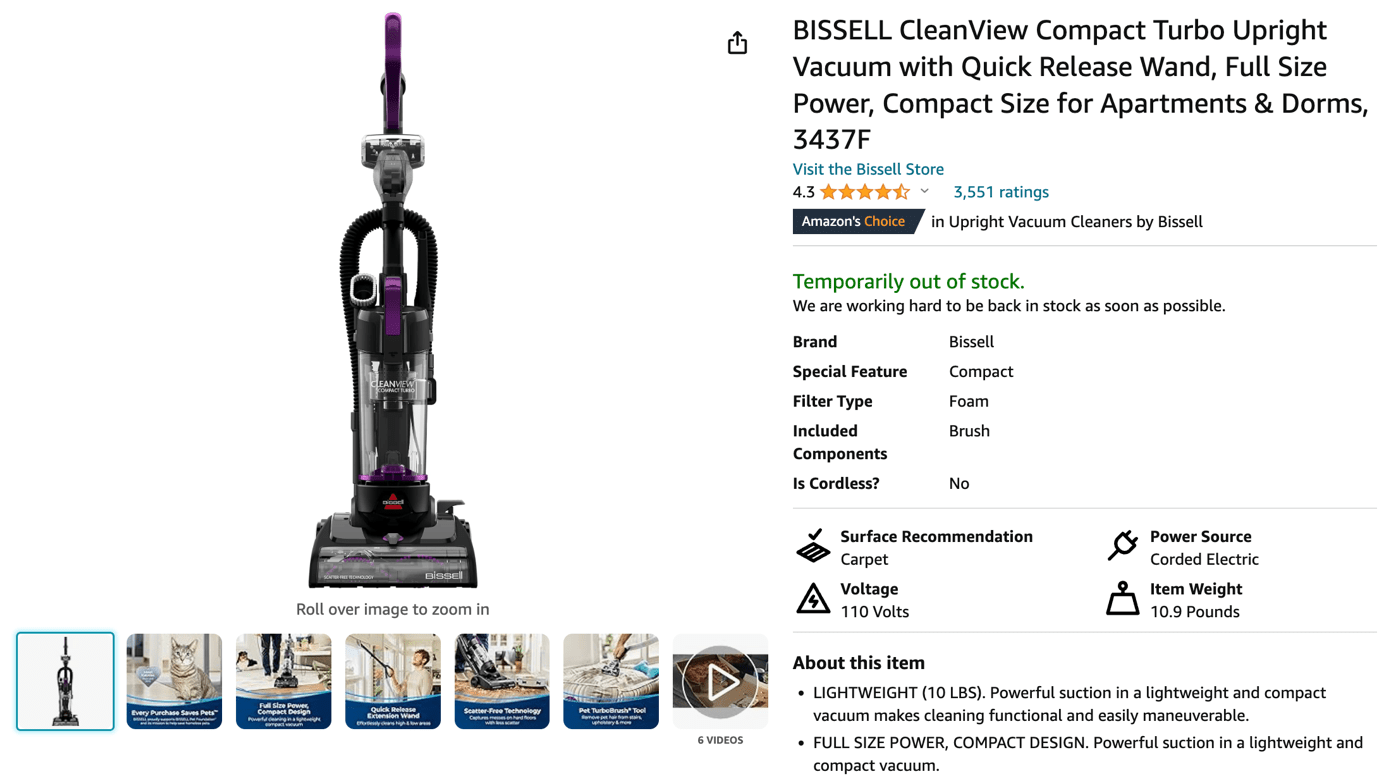
If you look closely, you’ll notice that all the photos in this listing (excluding the main image) are themed.
Here’s a better look:
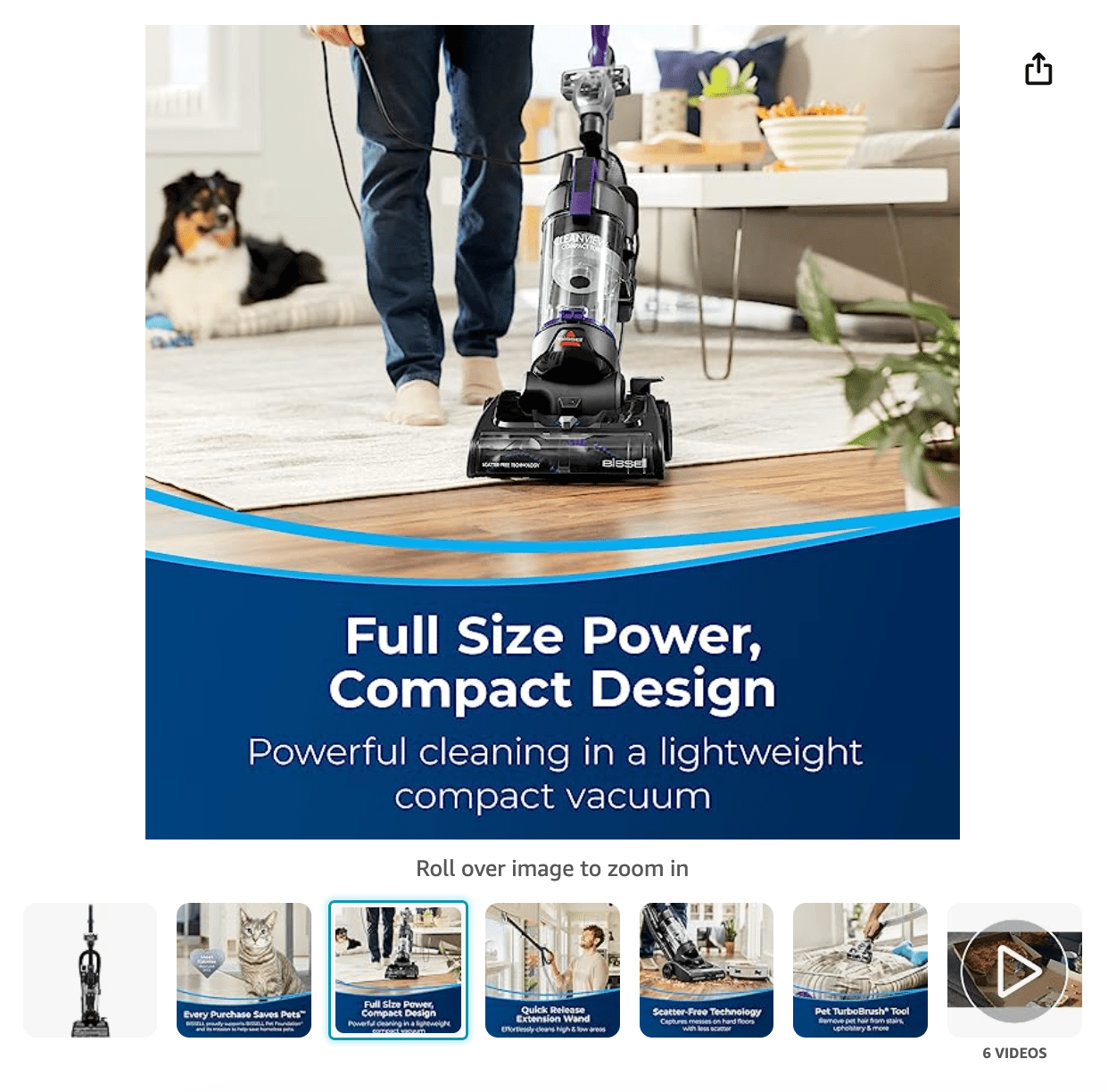
The blue strip serves as a visual anchor, drawing the viewer’s attention to the product’s key selling points. It also creates a cohesive brand identity. This is an excellent way to appease both users and the Amazon algorithm.
The images are also crisp and clear; they allow you to easily zoom in to see the vacuum’s details. The listing showcases the vacuum from various angles (front, back, and side), giving a comprehensive view of the product.
The combination of high-quality visuals, informative details, and a cohesive theme creates a positive impression that encourages shoppers to learn more about the product. And, of course, it’s also one of the reasons why this listing claims the top spot among search results.
3.Persuade with Power-Packed Bullet Points
When it comes to online shopping, attention spans are fleeting. Shoppers scan, not read, and your bullet points are often the first (and sometimes only) impression they get of your product’s features and benefits. That’s why crafting persuasive, power-packed bullet points is essential for capturing attention, driving clicks, and boosting sales.
Think of your bullet points as mini sales pitches, each one designed to highlight a key aspect of your product and answer the question: “What’s in it for me?” They should be concise, informative, and above all, persuasive.
How can you optimize your Amazon listing with bullet points?
- Focus on Benefits, Not Just Features: Don’t just list the technical specifications of your product. Instead, translate those features into tangible benefits that resonate with your target audience. For example, instead of saying “1080p HD camera,” say “Capture stunningly clear videos and photos that will make your memories last a lifetime.”
- Use Strong, Actionable Language: Avoid passive voice and weak verbs. Instead, use active verbs that create a sense of urgency and excitement. For example, instead of saying “This product is easy to use,” say “Effortlessly create professional-quality videos with our intuitive interface.”
- Highlight Your Unique Selling Proposition (USP): What makes your product stand out from the competition? Is it more durable, more affordable, or more innovative? Make sure your bullet points showcase your USP and give shoppers a reason to choose your product over others.
- Use Numbers and Data: Whenever possible, back up your claims with concrete numbers and data. This adds credibility to your bullet points and helps shoppers quantify the value of your product. For instance, instead of saying “This battery lasts a long time,” say “Enjoy up to 10 hours of continuous playtime on a single charge.”
- Front-Load Your Most Important Information: The first few bullet points are the most visible; make sure they contain your most compelling selling points. Save the less important details for later bullet points.
- Keep it Concise: Bullet points should be short and sweet. Aim for one to two lines per bullet point, using no more than two sentences.
- Use Keywords Strategically: While your primary focus should be on persuasion, don’t forget to incorporate relevant keywords into your bullet points. This will help your listing rank higher in search results and attract more qualified buyers.
If you want to master the art of bulleted listings, get some help from Search Berg’s Amazon product listing team. Our experts understand the nuances of Amazon’s algorithm and can help you craft persuasive bullet points that are optimized for search visibility.
4.Price It Right: The Sweet Spot Between Profit and Persuasion
While it may not seem immediately obvious, the price you set for your product on Amazon can significantly impact its ranking in search results. Amazon’s A9 algorithm, the mastermind behind its search rankings, takes into account various factors to determine which products get displayed first, and price is one of them.
Why does price matter? It boils down to a concept known as “sales velocity.” This refers to how quickly your product sells compared to similar products in the same category. Products with higher sales velocity are generally perceived as more popular and relevant, and Amazon’s algorithm rewards them with better visibility in search results.
So, where does pricing come in? A competitive price can entice shoppers, leading to more sales and a higher sales velocity. Conversely, an overpriced product may deter potential buyers, resulting in fewer sales and a lower ranking.
However, it’s not as simple as just lowering your price to the lowest possible point. While a lower price can certainly boost sales in the short term, it can also eat into your profit margins and even damage your brand image if customers perceive your product as cheap or low quality.
The key is to find the optimal price point, one that strikes the perfect balance between affordability for customers and profitability for you.It’s a delicate balancing act that requires careful consideration of several factors:
- Cost of Goods Sold (COGS): This includes the cost of materials, labor, and any other expenses directly related to producing your product. Your price needs to cover your COGS and leave room for profit.
- Competitor Pricing: Take a close look at what your competitors are charging for similar products. Are you in the same ballpark? If your price is significantly higher, justify that premium with exceptional quality, features, or branding.
- Perceived Value: The price of your product should align with the value it provides to customers. If your product solves a major pain point or offers unique features, you may be able to charge a premium. But if it’s a commodity item, you’ll need to stay competitive on price.
- Profit Margins: Don’t forget about your profit margins. Your price needs to be high enough to cover your expenses and leave you with a healthy profit, but not so high that it deters potential buyers.
- Psychological Pricing: Consider using psychological pricing tactics, e.g., ending your price in .99 or .95. This can make your product seem more affordable and appealing to shoppers.
- Discounts and Promotions: Offering occasional discounts or running promotions can incentivize shoppers to buy and help you clear out excess inventory. But be careful not to discount too often, as this can devalue your brand and erode your profit margins.
Be open to experimenting and adjusting your prices based on market trends and customer feedback. Amazon’s competitive terrain is constantly shifting, and your pricing should be agile enough to adapt.
Recommended Read: The Right Way to Approach Dynamic Pricing
5. Unleash Your Product’s X Factor
Certain Amazon listings seem to possess an almost magnetic pull. They effortlessly draw in shoppers, captivating their interest and compelling them to buy. These aren’t just any listings; they’re the ones that have tapped into their product’s X factor.
But what exactly is this elusive X factor? It’s the art of showcasing what makes your product unique, that special something that sets it apart from the competition. It’s the combination of features, benefits, and brand story that resonates with your target audience on an emotional level. It’s the reason why someone chooses your product over a dozen others that look nearly identical.
The X factor is that intangible quality that makes your product an experience instead of just a purchase. It’s the feeling of excitement when a new gadget arrives at your doorstep, the satisfaction of finding the perfect outfit for a special occasion, the comfort of knowing you’re using a product that aligns with your values.
And here’s the kicker: products with a strong X factor don’t just attract more buyers; they also command higher prices, enjoy greater customer loyalty, and drive more sales. They become the go-to choice for their niche, the brand that customers rave about to their friends and family.
But how do you identify your brand’s X factor?
It starts with introspection.
Ask yourself:
- What are your brand’s core values?
- What kind of personality do you want your brand to project?
- What sets your brand apart from the competition?
- What kind of experience do you want your customers to have?
Once you have a clear understanding of your brand’s essence, you can start infusing it into every aspect of your Amazon presence. Your product listings should reflect your brand’s personality through your choice of words, imagery, and overall aesthetic. Your customer service interactions should be consistent with your brand’s values and voice.
For example, if your brand is passionate about sustainability, your Amazon product listings could feature eco-friendly materials and packaging, while your descriptions could highlight your commitment to reducing your environmental footprint. You could also use natural, earthy tones in your images and graphics to reinforce your brand’s eco-conscious message.
Caboo’s Amazon listing for their tree-free paper napkins is a prime example of how to effectively highlight a product’s X factor.
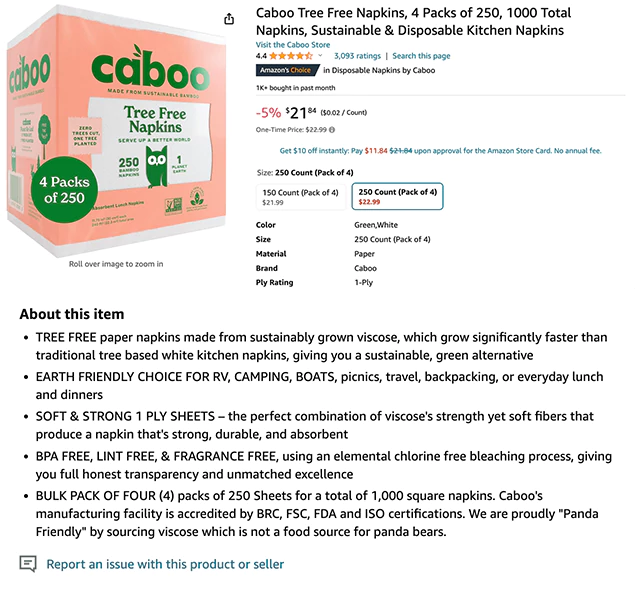
The X factor here is Caboo’s commitment to sustainability. This is evident from the very first bullet point, which emphasizes that the napkins are “TREE FREE” and made from sustainably grown viscose. This immediately sets them apart from traditional tree-based napkins and appeals to consumers who prioritize eco-friendly products.
Similarly, if your brand is known for its quirky sense of humor, you could inject some playful language and puns into your product descriptions and bullet points. Your images could showcase your products in unexpected or humorous ways, and your customer service interactions could be peppered with witty banter.This could be your X factor.
Or perhaps your brand is synonymous with luxury and exclusivity. In this case, your product listings could feature high-end materials and finishes, while your descriptions could emphasize the craftsmanship and attention to detail that goes into each product. Your images could showcase your products in opulent settings, and your customer service interactions could be characterized by impeccable manners and a focus on personalized attention.
The key is to ensure that every touchpoint with your customers reinforces your brand’s X factor. By creating a consistent and cohesive brand experience, you can build trust, foster loyalty, and drive more sales on Amazon.
6. Encourage and Respond to Customer Reviews
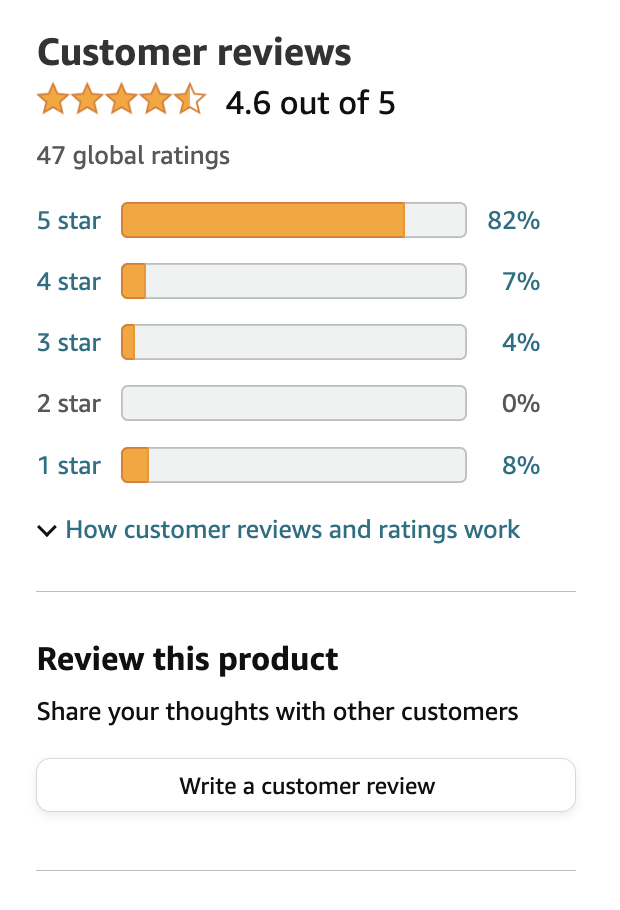
Think of your Amazon product listing as a bustling party. You’ve got the perfect ambiance, the right music, and delicious snacks laid out. But something’s missing… the buzz of conversation, the laughter, the energy that makes a party truly memorable.
Customer reviews are that missing ingredient. They’re the life of the party, the social proof that tells potential buyers your product is worth checking out. And just like a lively conversation at a party, reviews can create a sense of excitement and momentum that draws more people in.
Amazon’s algorithm also takes notice. A product with a high volume of positive reviews is often perceived as more trustworthy and desirable, leading to increased visibility in search results and a higher likelihood of conversion. It’s a virtuous cycle: more reviews lead to more sales, which lead to even more reviews, propelling your product to the top of Amazon search rankings.
So, how do you harness the power of customer reviews to skyrocket your Amazon sales? It starts with a proactive approach to gathering feedback and engaging with your customers.
Encouraging Customer Reviews
The first step is to actively encourage your customers to leave reviews.
You can do this in several ways:
- Follow-Up Emails: Send a polite, personalized email a few days after a customer receives their product. Thank them for their purchase, express your hope that they’re enjoying it, and gently invite them to share their thoughts in a review. Keep it brief, friendly, and focused on their experience.
- Product Inserts: A simple thank-you card or flyer tucked into your product packaging can work wonders. Include a brief message expressing your gratitude for their purchase and a clear call to action, guiding them to your product page to leave a review. You can even sweeten the deal with a small discount code for their next purchase.
- Amazon’s “Request a Review” Button: Amazon makes it easy for sellers to request reviews with their built-in button. This sends an automated email to your customers, prompting them to share their feedback. It’s a convenient way to reach a large number of customers at once.
- Early Reviewer Program: If you’re a new seller struggling to get those initial reviews, consider enrolling in Amazon’s Early Reviewer Program. This program incentivizes customers to leave reviews in exchange for a small reward, giving your product a much-needed boost in social proof.
The key is to make it as easy as possible for customers to leave a review. Provide clear instructions, offer incentives if appropriate, and most importantly, make it clear that you value their feedback. By actively soliciting reviews, you’ll boost your Amazon ranking and foster a community of engaged customers who feel heard and valued. This can lead to increased brand loyalty, repeat purchases, and a positive reputation that attracts even more buyers.
Responding to Customer Reviews
Responding to reviews, both positive and negative, is essential for building trust and credibility with your customers. It’s like maintaining a conversation at that party we talked about earlier. You wouldn’t just ignore someone who’s trying to talk to you, would you? You’d engage with them, acknowledge their comments, and show that you’re listening.
The same principle applies to customer reviews. Every review, whether glowing or critical, is an opportunity to connect with your customers, build rapport, and demonstrate your commitment to their satisfaction.
- Positive Reviews: When a customer takes the time to leave a positive review, it’s a gift; don’t let it go unappreciated. Respond with a personalized message, thanking them for their kind words and expressing your gratitude for their business. This simple act of acknowledgment can go a long way in fostering customer loyalty and encouraging repeat purchases.
- Negative Reviews: No one likes negative feedback, but it’s an inevitable part of doing business. When you receive a negative review, don’t panic or ignore it. Instead, take a deep breath and address it promptly and professionally. Apologize for any inconvenience caused, acknowledge their concerns, and offer a solution to their issue. This demonstrates that you care about your customers’ experience and are willing to go the extra mile to make things right.
- The Ripple Effect: Your responses to reviews aren’t just for the reviewer; they’re also for potential customers who are reading them. When shoppers see that you actively engage with your customers, respond to their feedback, and go above and beyond to resolve issues, it paints a picture of a brand that truly cares. This can significantly influence their decision to purchase from you, as they know they can trust you to stand behind your products and provide excellent customer service.
Research has shown that customers are more likely to purchase from brands that respond to reviews, even if those reviews are negative. This is because it demonstrates transparency, accountability, and a commitment to customer satisfaction: qualities that are highly valued by modern consumers.
By demonstrating excellent customer service and a willingness to resolve issues, you can win over hesitant buyers and build a positive brand reputation on Amazon listings.
7. Utilize Fulfillment by Amazon (FBA) for Faster Shipping and Prime Eligibility

Imagine having a personal team of experts handling the storage, packing, shipping, and even customer service for your products. That’s essentially what Fulfillment by Amazon (FBA) offers.
It’s a service provided by Amazon where sellers send their inventory to Amazon’s fulfillment centers. When a customer places an order, Amazon picks, packs, and ships the product on your behalf. They also handle customer service inquiries and returns, taking a significant burden off your shoulders.
FBA allows you to leverage Amazon’s vast logistics network and expertise, freeing you up to focus on other aspects of your business, e.g., product development and marketing. It’s like having your own personal warehouse and fulfillment team without the overhead costs and logistical headaches.
While many sellers view FBA as a convenient way to outsource fulfillment and customer service, its benefits extend far beyond logistics.
FBA’s Impact on Amazon Search Rankings and Sales
The Amazon A9 algorithm, the driving force behind its search rankings, prioritizes customer satisfaction. FBA plays a critical role in achieving this by offering several benefits that the algorithm favors:
- Prime Eligibility: FBA products automatically become eligible for Amazon Prime, the subscription service that offers free two-day shipping and other perks to its members. Prime members are Amazon’s most loyal and active shoppers, and they often filter their searches to show only Prime-eligible products. By using FBA, you instantly tap into this massive customer base and increase your chances of appearing in their search results.
- Faster Shipping Times: FBA products are typically shipped faster than merchant-fulfilled products, as they’re already stored in Amazon’s fulfillment centers and ready to ship. This faster shipping time contributes to a positive customer experience, which is a key factor in Amazon’s ranking algorithm.
- Lower Return Rates: FBA handles customer service and returns on your behalf, ensuring a seamless experience for shoppers. This can lead to lower return rates, which is another factor that Amazon’s algorithm takes into account when ranking products.
- Competitive Advantage: In crowded markets, FBA can give you a competitive edge over sellers who don’t offer Prime shipping. Shoppers are more likely to choose a product with fast, free shipping, even if it’s slightly more expensive.
FBA can significantly improve your product’s visibility and ranking in Amazon search results. This increased exposure means you walk away with more clicks, more views, and more sales.
How to Optimize for FBA
To make the most of FBA, start by ensuring your products are eligible for the program. This means they need to meet Amazon’s packaging and labeling requirements, and be in stock and ready to ship to Amazon’s fulfillment centers.
Once your products are in FBA, focus on optimizing your listings to highlight the Prime badge and fast shipping options. Clearly communicate these benefits in your product titles, bullet points, and descriptions. Consider adjusting your pricing strategy to factor in FBA fees, ensuring your prices remain competitive while maintaining profitability.
Actively monitor your inventory levels and replenish stock promptly to avoid running out of stock, which can negatively impact your rankings.
Additionally, leverage Amazon’s marketing and advertising tools, e.g., Sponsored Products and Sponsored Brands (more on these in the next section), to maximize the visibility of your FBA products and attract more buyers.
8. Drive Conversions with Targeted Ads
While organic search optimization is essential for long-term success on Amazon, targeted advertising can provide a powerful boost to your sales in the short term. Think of it as turbocharging your listing’s visibility, reaching a wider audience, and driving highly qualified traffic directly to your product page.
Amazon offers a suite of advertising tools designed to help sellers reach their target audience at every stage of the buyer’s journey.
Here’s how you can leverage these tools to maximize your conversions:
- Sponsored Products: This pay-per-click advertising model allows you to promote individual product listings in search results and on relevant product pages. By targeting specific keywords, you can ensure that your ads appear in front of shoppers who are actively looking for products like yours.
- Sponsored Brands: These ads appear at the top of search results and showcase your brand logo, a custom headline, and multiple product listings. They’re a great way to increase brand awareness and drive traffic to your product portfolio.
- Sponsored Display: These display ads appear on and off Amazon, targeting shoppers who have viewed your products or similar products in the past. They’re a powerful tool for retargeting potential customers and reminding them of your brand.
- Amazon DSP: The Demand Side Platform (DSP) allows you to programmatically buy display and video ads across Amazon’s owned and operated properties, as well as third-party websites and apps. This gives you access to a wider audience and allows you to target shoppers based on their interests, demographics, and browsing behavior.
The key to successful Amazon advertising is to create highly targeted campaigns that resonate with your ideal customer.
This involves:
- Keyword Research: Identify the most relevant and high-converting keywords for your products (refer to the first section of this blog).
- Compelling Ad Creative: Design eye-catching ads with persuasive copy and high-quality images.
- Bid Optimization: Set competitive bids to ensure your ads get seen, but don’t overspend.
- Performance Tracking: Monitor your ad performance regularly and make data-driven adjustments to optimize your campaigns.
By combining organic search optimization with targeted advertising, you can create a powerful one-two punch that drives traffic, boosts conversions, and fuels your Amazon sales growth.
Turn to the Amazon SEO Pros
You’ve got the blueprint, the insider knowledge, the tactics to transform your Amazon listings from wallflowers to head-turners. But here’s the cold, hard truth: execution is everything.
This blog is the right start, but it’s just the tip of the iceberg. Turning theory into practice takes time, dedication, and a whole lot of trial and error. And let’s be honest, who’s got time for that when you’re running a business?
That’s where Search Berg steps into the picture. Our team lives and breathes Amazon search optimization. We’ve helped countless businesses navigate the complexities of Amazon’s algorithm, optimize their listings for search, and achieve the kind of results that make jaws drop.
If you’re ready to stop playing the guessing game and start seeing real results, sign up for our Amazon listing optimization services. Let our team of experts handle the heavy lifting so you can focus on what you do best: running your business.
Is Your Product Hidden in Plain Sight on Amazon?
If it’s not ranking on the first page, it might as well be invisible. Let Search Berg shine a spotlight on your product, boosting its visibility and driving sales. It all starts with a free, no-obligation consultation!
No spam, just expert advice!













